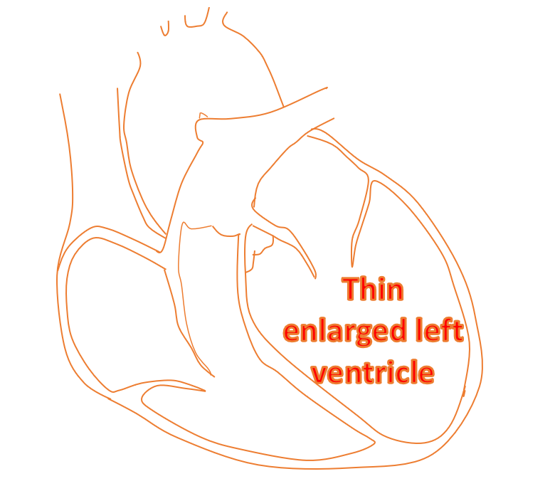Dilated cardiomyopathy
Dilated cardiomyopathy is a disease of the heart muscle in which the contractile power gradually decreases. Unless it is due to a reversible cause which can be removed, the disease is usually progressive. It predominantly involves the left lower chamber of the heart (left ventricle) which becomes progressively weak and enlarged. Occasional cases have been noted in which the progression halts at some stage and remains stable for a long period.

What are the important symptoms of dilated cardiomyopathy?
Breathlessness is the most important symptom of dilated cardiomyopathy. A weak heart muscle is unable to pump out blood well in response to the needs of the body. This leads to damming up of blood in the left atrium (upper chamber) and the blood vessels of the lungs. Consequent lung congestion makes the lungs heavier and breathing difficult. In initial stages breathlessness is on exertion, while in later stages it occurs in sleep and at rest.
Another important symptom is fatigue. This is because the low amount of blood pumped out by the heart is not sufficient to meet the needs of the body. Low output can reduce the blood flow to the kidneys and decrease urine output. Fluid gets collected in different parts of the body, mostly in the legs around the ankles producing swelling of the feet (edema).
In some persons with dilated cardiomyopathy heart beats may become irregular (atrial fibrillation). They may have palpitation.
How can dilated cardiomyopathy be treated?
In the initial stages, it can be treated by medications which reduce the workload of the heart and those which increase urine output. Medications for controlling the heart rate are also added if the heart rate goes up. When medications are not effective, some of them get relief with devices known as heart failure device or cardiac resynchronization therapy. These are expensive devices which give electrical signals to different parts of the heart so that the heart muscles contract in synchrony, improving the pump function. Those who have a risk of life threatening heart rhythm disorders benefit from a device known as implantable cardioverter defibrillator (ICD). A device which is a combination of both – combo device or CRT-D is also available, but of course very expensive. Finally, those not suitable for these or those who are still symptomatic while on optimal medications and device therapy can be placed on the waiting list for heart transplantation. They will receive a heart transplant if they are residing near a heart transplant center and are fortunate to get a matched donor before their condition deteriorates too much.
Are patients with dilated cardiomyopathy prone for development of stroke?
Due to the poor pumping function of the heart, circulation is sluggish and they have a tendency for clot formation within the chambers of the heart. This tendency will be enhanced if they develop atrial fibrillation. Clots from the heart can move to the blood vessels of the brain and block them resulting in stroke. They can also develop clots in the veins of the legs due to poor mobility and sluggish circulation. Selected persons are given medications to prevent clot formation, though it carries a bleeding risk and requires close monitoring.